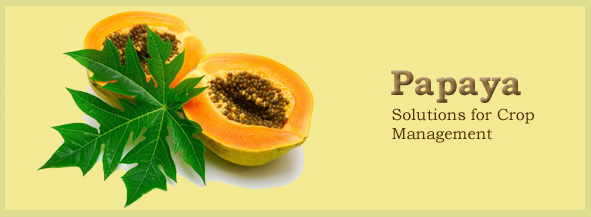Soil and climate
Climate
 Papaya is basically a tropical plant, which
requires high temperature, ample sunshine and
adequate moisture in the soil and is highly sensitive to frost
but it can also be grown in the mild sub-tropical regions of the
country up to 1,000 m above the sea level.
Temperature is one of the most important climatic factors
determining the success of papaya cultivation. Night temperature
below 12 - 14 oC for several hours during winter
season affects its growth and yield. It is also very much
sensitive to frost, strong wind and water stagnation. Regions having summer temperature between 38 to 48oC and where
winter temperature does not fall below 5oC are ideal for its growth.
Temperature below 10oC retards maturity, ripening and to certain
extent the growth and fruit set. It is adapted to a wide range
of rainfall conditions from 35 cm to 250 cm annual
precipitation. Papaya is basically a tropical plant, which
requires high temperature, ample sunshine and
adequate moisture in the soil and is highly sensitive to frost
but it can also be grown in the mild sub-tropical regions of the
country up to 1,000 m above the sea level.
Temperature is one of the most important climatic factors
determining the success of papaya cultivation. Night temperature
below 12 - 14 oC for several hours during winter
season affects its growth and yield. It is also very much
sensitive to frost, strong wind and water stagnation. Regions having summer temperature between 38 to 48oC and where
winter temperature does not fall below 5oC are ideal for its growth.
Temperature below 10oC retards maturity, ripening and to certain
extent the growth and fruit set. It is adapted to a wide range
of rainfall conditions from 35 cm to 250 cm annual
precipitation.
Soil
type
Varieties of soils are suitable for its cultivation provided
these are well drained and aerated. A rich, well-drained sandy
loam soil is ideal for its cultivation. It also grows well in
deep rich alluvial soils on banks and deltas of big rivers. It
can also be grown in calcareous and stony soils provided these
are dressed with heavy doses of organic manures. Well drained,
medium black to red loamy soils with a pH range of 6.5 to 7.0
are suitable to grow this fruit. Extreme situations like soils
with high pH (8.0) and low pH (5.0) should be avoided.
Papaya is highly susceptible to water logging and roots get
damaged due to stagnant water.
|








 Papaya is basically a tropical plant, which
requires high temperature, ample sunshine and
adequate moisture in the soil and is highly sensitive to frost
but it can also be grown in the mild sub-tropical regions of the
country up to 1,000 m above the sea level.
Temperature is one of the most important climatic factors
determining the success of papaya cultivation. Night temperature
below 12 - 14 oC for several hours during winter
season affects its growth and yield. It is also very much
sensitive to frost, strong wind and water stagnation. Regions having summer temperature between 38 to 48oC and where
winter temperature does not fall below 5oC are ideal for its growth.
Temperature below 10oC retards maturity, ripening and to certain
extent the growth and fruit set. It is adapted to a wide range
of rainfall conditions from 35 cm to 250 cm annual
precipitation.
Papaya is basically a tropical plant, which
requires high temperature, ample sunshine and
adequate moisture in the soil and is highly sensitive to frost
but it can also be grown in the mild sub-tropical regions of the
country up to 1,000 m above the sea level.
Temperature is one of the most important climatic factors
determining the success of papaya cultivation. Night temperature
below 12 - 14 oC for several hours during winter
season affects its growth and yield. It is also very much
sensitive to frost, strong wind and water stagnation. Regions having summer temperature between 38 to 48oC and where
winter temperature does not fall below 5oC are ideal for its growth.
Temperature below 10oC retards maturity, ripening and to certain
extent the growth and fruit set. It is adapted to a wide range
of rainfall conditions from 35 cm to 250 cm annual
precipitation.